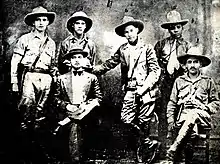Farabundo Martí | |
|---|---|
 Martí in 1929 | |
| Born | Agustín Farabundo Martí Rodríguez 5 May 1893 |
| Died | 1 February 1932 (aged 38) |
| Cause of death | Execution by firing squad |
| Nationality | Salvadoran |
| Occupation(s) | Revolutionary leader, activist |
| Political party | Communist Party of El Salvador |
| Signature | |
Agustín Farabundo Martí Rodríguez (Spanish pronunciation: [faɾaˈβundo maɾˈti]; 5 May 1893 – 1 February 1932) was a Marxist-Leninist activist and a revolutionary leader in El Salvador during La Matanza.
Early life

Martí was born in Teotepeque, a farming community located in Departamento de La Libertad, El Salvador. After graduating from Saint Cecilia Salesian School in Santa Tecla, he enrolled at the University of El Salvador, in San Salvador. From early on, he condemned the exploitation of the country's poor for the profit of the rich. He became known as a Salvadoran revolutionary and for many, a martyr.
Revolutionary activity
| Part of a series on |
| Socialism |
|---|
 |
|
Categorized by Miguel Mármol, in his testimonio, an intellectual but a proletarian-like young man,[1] Martí decided to drop out of his Political Science and Jurisprudence program at the University of El Salvador to fight for his community and nation. In 1920, he was arrested for taking part, along with other students, in a protest against the then-ruling Meléndez-Quiñónez dynasty. Martí's arrest subsequently led to his exile from the country, and he took up residence in Guatemala and Mexico until his return to El Salvador in 1925.
.jpg.webp)
Returning from exile, Martí was appointed as a representative to go to the conference of the Anti-Imperialist League of the Americas in New York City. Upon arriving in New York, he was once again arrested and then released. In the meantime, he worked with the Nicaraguan revolutionary leader Augusto César Sandino.[2]

Martí became involved in the founding of the Communist Party of Central America, and he led a communist alternative to the Red Cross, the International Red Aid, serving as one of its representatives. Its goal was to help poor and underprivileged Salvadorans by the use of the Marxist-Leninist ideology. In December 1930, at the height of the country's economic and social depression, Martí was once again exiled because of his popularity among the nation's poor, and there were rumors of his upcoming nomination for President the next year.
Uprising and death

Once the new president was elected in 1931, Martí returned to El Salvador and, along with Alfonso Luna and Mario Zapata, began the movement that was later truncated by the military.[3] They helped start a guerrilla revolt of indigenous farmers. During that time, he was acting as the Interim General Secretary of the Party.[4]
The communist-led peasant uprising against the dictator Maximiliano Hernández Martínez was fomented by collapsing coffee prices, and it enjoyed some initial success but was soon drowned in a bloodbath and crushed by the Salvadoran military ten days after it had begun. Over 30,000 indigenous people were killed at what was to be a "peaceful meeting" in 1932, which became known as "La Matanza" ("The Slaughter").
President Hernández Martínez, who had himself toppled an elected government only weeks earlier, ordered Martí shot after a court-martial.
See also
References
- ↑ Roque Dalton, Miguel Marmol (Bogotá: Ocean Sur 2007), p. 186.
- ↑ Roque Dalton, Miguel Marmol (Bogotá: Ocean Sur 2007), p. 160.
- ↑ Página Oficial de la Juventud Farabundo Martí Archived 2008-03-07 at the Wayback Machine at jfarabundomarti.org
- ↑ Roque Dalton, Miguel Mármol (Bogotá: Ocean Sur, 2007), p. 186.